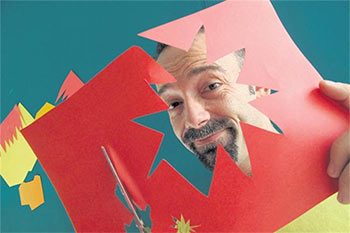Interview by Graciela Melgarejo in ADN Cultura (in English)
Only in present times is illustration seen in its own right
Born in Spain and residing in Argentina, the renowned artist, who also pens his own texts, reviewed the history of illustrations that have been and are an indissoluble part of books for children and teenagers
By Graciela Melgarejo - Image: Sebastián Szid - ADN Cultura

He has gone so far since he first started (in the city of San Jorge, Santa Fe –he was born in Madrid, Spain, that’s a fact, but he was raised in the province of Santa Fe in Argentina) working and making a living of his profession/trade/art, that it is hard to account for them all. Anyhow, if you take into account that one of the reasons for this interview is the conference Istvansch is presenting at the First Spanish-American Congress on the Spanish Language and Children and Youth Literature (Cilelij 2010) in Santiago de Chile, February 20-24, one may start to better hint his tenure in the Argentine and Spanish-American illustration world.
The Congress is organized by Fundación SM (Fundación Santa María, Spain) and the Office of the Director of Libraries, Archives, and Museums (Dibam) of Chile, is the first of its kind, and aims at providing “a global view of Spanish-American children and youth literature, both from the geographical (all Spanish-speaking countries and Brazil will be present) and from the historical (past, present, and future trends) standpoints.” In the afternoon of Thursday, February 25, Istvansch will present his “Notes on the History of Spanish-American Children’s Literature (From European to Local Aesthetic Styles and Schools; a Visual Tour).” This topic –he admits– has long interested him, although he had focused his analysis exclusively on the situation in Argentina.
-Has anything been written in this respect in Spain and the Americas?
-In fact, nothing, or little, has been written –both in Argentina and in the Americas. Why? Because the same happens with children’s books illustrations in general. My book La otra lectura [A Different Reading] (2005) was the first one on this issue to be published in Argentina and one of the few in Latin America. Only 30 years ago there were studies that questioned whether children’s literature even existed! How would anyone reflect on illustration? The issue was first studied 10 or 15 years ago, and it was because illustrators started to write and illustrate their books. A school of thought then started among us illustrators –in conferences, forums, seminars– that also attracted the attention to illustration.
-It must have been hard to find the sources for your presentation…
-Extremely. That is why I used “Notes” in the title. In Spain, I found some very good sources, e.g. the dissertation by Alberto Urdiales on illustration in Spain between 1900 and 1936, or the book by Jaime García Padrino. In the Americas there are considerably fewer sources: studies by Manuel Peña Muñoz (Chile), Antonio Orlando Rodríguez (Cuba) –an expert in children’s literature but who is better known for his novel Chiquita that received the Alfaguara Award in 2008–, a few in Brazil, and my book in Argentina. There is little in Nicaragua, El Salvador, Panama, and Paraguay, although now I found a history on Paraguayan children’s literature. The same happens in Colombia and Venezuela, two countries that have had and currently have quite an interesting literature for children, but where there little has been written in this respect.
-And, in your opinion, what is the reason for this scarcity of critical studies or reviews?
-I believe it is due to the fact that all publishing houses, and the institutions that are associated with children’s books started to focus on illustrations in the 1970s and 1980s, on the one hand; and on the other hand, because illustrators did not consider themselves as authors of their works, especially with respect to their copyright. For example, often times a book was reprinted without the illustrations of the first edition. And those illustrations were lost forever. I would say that this lag has been more social and political than aesthetic. Only in present times is illustration seen in its own right. So, with the advice of Pablo Medina–who, with his library La Nube is making an incredible recovery and preservation job– I also conducted a survey among researchers, publishers, and illustrators, and requested them to forward it to their colleagues, where I asked them to recall what they knew about illustrations in children’s books in their countries.
-And what were your findings?
-Extremely varied. For example, in Honduras one illustrator –Wilmer Murillo– complained that, except for schoolbooks, nothing was done in his country, although he works for other markets, and on the Internet one may find interviews that he answered for US journals. This is to be thanked to new technologies that enable many illustrators to send their work out to the world, even when “nothing” happens in their own countries. Another finding is that, in times of dictatorship, everything, including illustration, turns duller, didactic, moralizing, while everything bursts and there are extremely aesthetic quests with democracy. This is precisely what happened in our country in the 1960s and part of the 1970s with El quillet de los niños [The Quillet for Children], directed and penned by Beatriz Ferro, and illustrated, among others, by Oski, Alberto Breccia, and Ajax Barnes. There was an awareness of how to “educate” without necessary teaching right from wrong. This was also the case in Spain during the 1910s and 1920s with the books by Saturnino Calleja, and later, during the Second Spanish Republic. After the fall, there was a diaspora of illustrators to the Americas.
-And then your presentation shifts to this continent…
-Of course. These artists flee to Mexico, Puerto Rico, Cuba, and Argentina. Constancio Vigil hired these people and created the Biblioteca Billiken. Some of them grew; some did not; others returned to Spain and continued to work in that country. In any case, their influence was extremely important, although there were some relevant Latin American publications at that time. Billiken, created in 1919; El Peneca in Chile, first published in 1908, or Tricolor in Venezuela –which was launched to compete with Billiken in 1949– where distributed throughout the continent and showcased the work of wonderful illustrators and authors. Interestingly, their contents were not limited to schoolwork, they were also recreational. This thriving editorial market ended when the Disney emporium launched its publications, in their charge during the 1950s, to create virtually a monopoly.
-I believe that all this information should be part of a second book.
-In fact, I have thought about it because I already have some isolated papers and what I would need is just three or four months to write it. The focus would be what has happened in terms of children’s books illustrations in the past five years. Now that the language of illustration and its characteristics are widespread, the market has shifted to the other end and the focus is exclusively placed on illustration. The risk is that it may be bastardized as merely “adding a little colour.”
-And how does an author avoid this new danger?
-By being extremely creative. The picture books that we created in 2003 for Ediciones del Eclipse sought to take the place of imported books, which had become extremely expensive. In a picture book, text and image work inseparably to tell a story, because images say as much as words do. For example, Irene Singer is now directing the collection 2x4 Tango para Pibes [2x4 Tango for Kids], for readers of all ages, which aims at introducing tango in the already-known field of illustrated books. In my last book, Todos podemos dibujar [Everybody Can Draw], the trigger were colouring books, but with a creative and interactive twist. Now I am thinking of a new series on typical school materials, which oftentimes are quiet “stigmatized.” And I might as well write a punk book. Why not?
